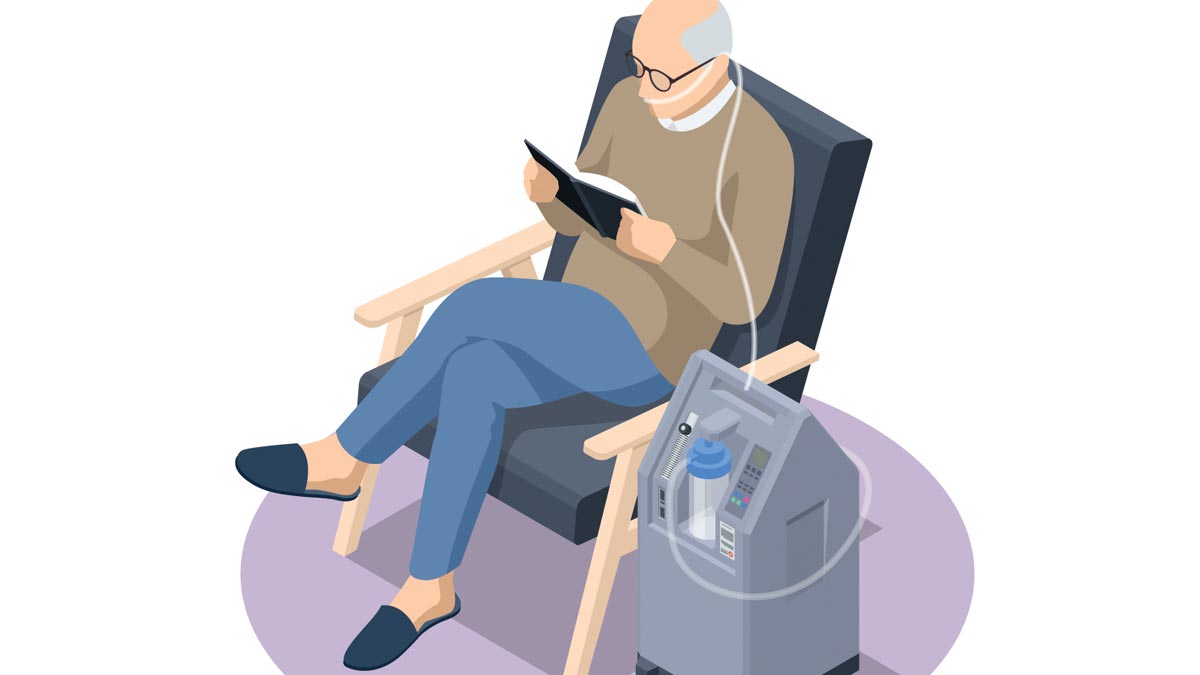The COVID-19 pandemic tested the resources of the U.S. health care system. As the demand for hospital beds rose, many victims of the virus were forced to fend for themselves at home, and, because oxygen deprivation and lung infections are frequent complications of the virus, prescribed oxygen therapy became increasingly common.
For those who have difficulty breathing, oxygen is considered a prescription drug and must be prescribed by a licensed physician or practitioner. Lack of oxygen can cause shortness of breath, headaches, increased heart rate, poor concentration and confusion. Some of the most common conditions that may require supplemental oxygen therapy include: chronic obstructive pulmonary disease, emphysema, bronchiectasis, pulmonary fibrosis and recurring congestive heart failure. When an oxygen unit is properly used, it can help a patient lead a more active lifestyle, sleep better and feel less fatigued.
TJ Thompson of Atlantic Respiratory Services explained the importance of patients looking at prescribed oxygen as a drug that can help enhance quality of life.
“It will allow you to stay active and continue to do the things you enjoy doing,” Thompson explained.
As the president of Charleston’s oldest and largest independent home respiratory provider, Thompson has experience helping patients with their therapy. She emphasized strategies that will give them an opportunity for a better and more active life.
First, it is important that patients – and others around them – never smoke around oxygen.
“Talk to your physician about a smoking cessation plan. If you have a lung disease such as COPD and are still smoking, you are accelerating the decline of your lung function,” she advised, adding that environmental irritants should also be avoided when possible.
Breathing skills and relaxation techniques are helpful, and building flexibility and strength with an exercise regimen or pulmonary rehab, if prescribed, also can be useful. Of course, maintaining healthy eating habits will optimize care, as will ensuring that breathing treatments and medications are being administered appropriately.
“Set manageable goals for yourself,” asserted Thompson. “Learning how to manage your activity level, your breathing and your medications will allow you to achieve your objectives as well as master new skills and create new goals.”
The most common type of equipment is a stationary oxygen concentrator – a small, easy to use machine that runs on electricity and “concentrates” the air in the room by removing nitrogen and other elements to provide oxygen-rich air to a patient.
Thompson clarified that “as long as you have electricity and the unit is working properly, oxygen will be supplied, and it does not run out. An oxygen concentrator can produce oxygen 24 hours and last five years or more.”
Although oxygen is not flammable or explosive, patients should be aware of the risks and measures necessary to ensure safety. Simply put, fires might burn more rapidly than usual because oxygen concentrators and tanks both infuse the environment with oxygen. Therefore, sources of heat should be kept at least 5 feet away from the units when they are being used or stored, and patients should not use oxygen when handling electrical appliances such as hair dryers, curling irons, heating pads or electric razors. Patients who wear oxygen while sleeping should consider using 100% cotton bedding, which is less likely to produce static electricity. Of course, a fire extinguisher should be readily available in the case of an emergency.
For storage safety, units should not be enclosed in closets or trunks. Units should always be turned off when not in use, and they should be at least several inches away from walls or curtains. Nothing should ever be on or over the unit.
It is important to have backup equipment available and for homeowners to let their power company know about the life-sustaining equipment in their home. Notifying the electric company will help you receive priority service to restore electricity if there is a power failure.
Although the safety precautions may seem overwhelming, Thompson advised viewing oxygen therapy as you would any other medication.
“If used properly, it will help patients feel better, live longer and be able to do more.
And if it means a patient’s quality of life will improve, the efforts and precautions are well worth the effort,” she said.







